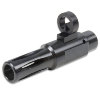OOO, can I come play at your house? That's a really nice rig, is the big one an old Southbend? My own is a little 13" Chinese one, does fine for my little hobby projects. Most of my lathe work is not gun related. Outside of personal hobby work I do a little contract work on motor and pump repair, custom pipe couplings and bushings etc. I put Price Pfister stem assemblies in my American Standard fixtures, I'd love to see the look on a plumbers face trying to figure that one out.
I love seeing your work post some more.
No, it's a Rahn-Larmon, 1920s vintage. Big sucker, about 4,000 lbs. I got it for $1,000, spent a lot of time reconditioning, and made a lot of custom tooling. That steady rest? Yeah, carved from 2.5" thick 7075 aluminum. The carriage stop also scratch built. Had to set up the one shot oiling system, as this thing started going through oil pretty quickly when I swapped out the 2 HP 3 ph 1,750 RPM motor for a single phase 3 HP 3,500 RPM unit, which gives me a spindle speed range of 32 to 1,020 RPM. I also made an electronic power feed unit that not only provides far superior surface finishes, but is just easier in general. I've got the 10" 3 jaw it came with, got a 13" 4 jaw, 5" rotating tailstock chuck, multiple live centers & drill chucks. X & Z axis DRO, as well as tailstock DRO. It's pretty well tooled now, other than no taper attachment. Even snaked the twin cutting head from an AMMCO 7500 so I can turn rotors!





This is the Hardinge I use for threading barrels most of the time:


Gotta love 26" barrels! Long enough that the receiver can stay attached!


I also have a Southbend Heavy 10L, an Atlas 618, an 1880s Barnes #5 and an 1896 Seneca falls that still has the treadles & wheel. Yes, I havea lathe addiction problem





















